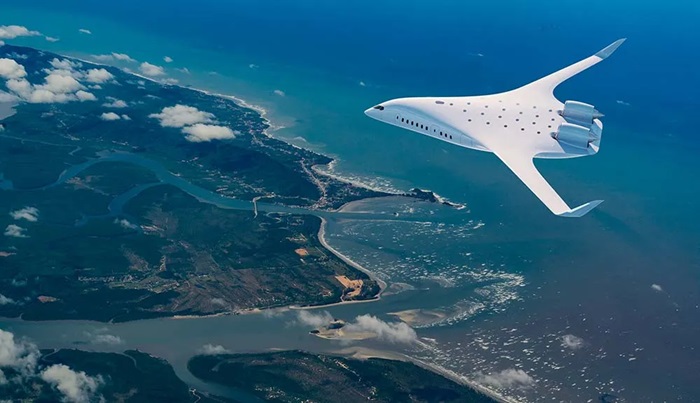Travel
Redefining Air Travel: Alaska Airlines’ Vision for Sustainable Aviation with JetZero

- Alaska Airlines invests in JetZero to pioneer a blended-wing-body airliner, aiming to reduce carbon emissions and enhance flight efficiency.
- The blended-wing-body design could significantly cut fuel use, with improved aerodynamics and advanced carbon fiber materials.
- JetZero’s innovative aircraft model offers potential for more spacious, comfortable cabins, and reduced environmental impact.
- Alaska’s partnership with JetZero aligns with its long-term strategy to achieve net-zero emissions by 2040 through innovative aviation technologies.
Alaska Airlines has a history of driving aviation innovation. It was the first airline in the United States to sell tickets online in 1995, and a year later, it pioneered the use of GPS for aircraft navigation. Now, Alaska Airlines is focussing on a new frontier: revolutionizing passenger jets to drastically reduce emissions.
The airline recently announced an investment in JetZero, a Long Beach, California-based business building a new type of aircraft known as the blended-wing-body (BWB) airliner. This initiative is part of Alaska Airlines’ broader innovation plan, which seeks to achieve net-zero carbon emissions by 2040. Although the specific value of the investment has not been published, it is consistent with the company’s commitment to sustainability.
“We do not want to be the cigarette industry in 20 years, where we’re regulated out of existence because people say it’s so bad to fly in an airplane,” said Pasha Saleh, who leads corporate development at Alaska Airlines. “We want to make sure we’re developing multiple solutions but actually driving each of them forward.”
JetZero’s blended-wing-body aircraft is a substantial departure from the classic tube-and-wing design that has dominated commercial flying. The BWB idea has a more integrated, triangular shape where the cabin and wings meet, which improves aerodynamics and lift. This design enables the plane to travel at higher altitudes, around 45,000 feet, hence lowering wind resistance. Furthermore, the use of lightweight, stitched carbon fibre instead of heavier materials such as bolted metal and composites allows the aircraft to carry hundreds of passengers while consuming just half the fuel, resulting in significant cost savings and environmental benefits.
“JetZero is one of these rare situations where everything gets better,” Saleh noted. “It’s so rare in engineering where you come across a solution where there are so few trade-offs, if any, to be made.”
JetZero’s Chief Technology Officer, Mark Page, has spent decades perfecting the BWB design, working on NASA prototypes in the 1990s and building drones with comparable forms in the 2000s. Despite years of development by NASA and major aircraft manufacturers, the BWB has yet to be constructed for commercial use, owing to a lack of financial incentives. According to JetZero CEO Tom O’Leary, the industry’s long standing mentality has been, “Why innovate when there’s a backlog of jet orders and fuel costs are low?”
However, technological advancements, such as improved computer modeling and carbon fiber materials, along with the urgent need to cut emissions, have moved the BWB concept closer to reality. The United States Air Force has even invested in JetZero to create a BWB cargo plane, which accounts for around 60% of the Air Force’s yearly jet fuel costs.
Airlines such as Alaska have increasing hurdles in terms of emissions and flight technology. Airplanes presently account for 2.5% of global emissions, which is likely to climb in the future years, prompting further scrutiny and regulation. Meanwhile, the cost of jet fuel, which accounts for approximately 20% of operating expenditures, has increased by 8% since 2019. With the industry’s goal of reaching net-zero emissions by 2050 rapidly approaching, there is an urgent need for new, more sustainable aircraft to enter service by 2035.
The JetZero model not only reduces passengers’ carbon footprints, but it also increases economy by cutting fuel burn per seat mile. JetZero’s offices, housed in a big hangar across from Long Beach Airport, includes a mock-up of the cabin complete with functional bins, foam-mat seats, and cutouts of the walls, ceiling, and windows. The cabin design places facilities at the back to save wait times, and there is a triangular service space in the front that may be used for more elaborate meal preparation, as well as an in-flight bar.
Walking through the prototype interior demonstrates how different this arrangement may be if airlines use the fuel and energy savings without over engineering for profit. The fuselage’s width allows for more than 15 seats abreast, with high ceilings and seating spaces that sprawl out from the cockpit. JetZero designers have even experimented with giving each seat its own luggage compartment.
Glen Noda, JetZero’s head of product design, stated that typical commercial jet design had reached its limitations. The bigger size of JetZero planes lowers the need to squeeze passengers for profit.
“The knee-jerk response for airlines is wanting to densify everything because that’s what you’ve done for 50 years, but that’s not what we need to do on this airline to be profitable,” Noda said.
Saleh stated that Alaska is thrilled about the possible technical breakthroughs and other benefits that such a jet may provide, including making air travel more comfortable, inexpensive, and accessible.
According to Saleh, airlines often lack the competence to undertake such research initiatives internally, therefore investing in and cooperating with startups is a more successful strategy. With the help of an industry partner like Alaska, great innovations can go to market and scale faster. Alaska’s venture arm is primarily focused on sustainability, with the goal of encouraging technologies that would lead to a more sustainable aviation future.
“We’re doing this because to get to a sustainable future for aviation, it’ll take ideas that either don’t exist today or currently only exist in a lab,” Saleh explained. “We want to be very active investors. We don’t want to place bets the way you would in a Las Vegas casino and hope one of them hits. We realize it’s going to take all of these things.”
Making this alliance a reality will require years of effort, innovation, and regulatory approval from the Federal Aviation Administration (FAA), as well as cautious attention to safety. In January, a Boeing-made jet’s door blew off mid-flight, raising aviation safety worries in Alaska. JetZero’s current plan expects certification in 2027 and commercial service by 2030. The FAA recently cleared a smaller, 1:8 size JetZero demonstrator plane for test flights, which are taking place at a secret location in the California desert.
JetZero is also developing a full-scale model and exploring prospective manufacturing sites. By collaborating with Alaska, the firm hopes to put its revolutionary vision into commercial service.
“We want to deploy these theories into practice,” JetZero’s O’Leary said. “People often say that’s a good theory, but it doesn’t work in practice. But that’s the definition of a good theory, that it does in fact work in practice.”


















































